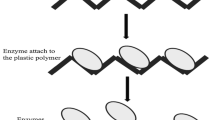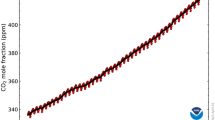Abstract
In sedimentary environments or clay-rich rocks, clay minerals are usually combined with organic matter; however, little research has focused on the effects of combinations of organic matter and clay minerals on the thermal degradation of organics and on subsequent hydrocarbon generation. In this study, the long-chain fatty acid octadecanoic acid (OA) and its derivative octadecy trimethyl ammonium bromide (OTAB) were selected as model organics. The organics were prepared for clay–organic associations with Na-based montmorillonite (Mt(Na)). The thermal decomposition behaviors of these associations were studied via thermogravimetric (TG/DTG) analysis. In the presence of Mt(Na), OA decomposed at 275.2 °C, decomposing sooner than pure OA. The thermal decomposition behavior of OTAB is nearly consistent with that of pure OTAB, but for interlayer OTAB, the decomposition temperature increased to higher than 300 °C. The results indicate that Mt(Na) plays a dual role in the thermal decomposition of fatty acid. Mt(Na) may accelerate the thermal decomposition of OA, and inherent solid acidity levels may be the key factor. In addition, the interlayer structure of Mt(Na) can increase the thermal stability of OA and OTAB. The above results further demonstrate that the thermal decomposition behavior of a given organic material may also depend on its structure and composition. In the presence of Mt(Na), organics with amino and amine structures are more stable than those with carboxyl groups.





Similar content being viewed by others
References
Jurg J, Eisma E. Petroleum hydrocarbons: generation from fatty acid. Science. 1964;144(3625):1451.
Shimoyama A, Johns WD. Catalytic conversion of fatty acids to petroleum-like paraffins and their maturation. Nature. 1971;232(33):140–4.
Galwey AK. The rate of hydrocarbon desorption from mineral surfaces and the contribution of heterogeneous catalytic-type processes to petroleum genesis. Geochim Cosmochim Acta. 1972;36(10):1115–30.
Johns WD. Clay mineral catalysis and petroleum generation. Annu Rev Earth Planet Sci. 1979;7:183–98.
Heller-Kallai L, Aizenshtat Z, Miloslavski I. The effect of various clay minerals on the thermal decomposition of stearic acid under ‘bulk flow’ conditions. Clay Miner. 1984;19(5):779–88.
Tannenbaum E, Kaplan IR. Role of minerals in the thermal alteration of organic matter—I: generation of gases and condensates under dry condition. Geochimicaet Cosmochimica Acta. 1985;49(12):2589–604.
Kennedy MJ, Pevear DR, Hill RJ. Mineral surface control of organic carbon in black shale. Science. 2002;295(5555):657–60.
Pan C, Jiang L, Liu J, Zhang S, Zhu G. The effects of calcite and montmorillonite on oil cracking in confined pyrolysis experiments. Org Geochem. 2010;41(7):611–26.
Keil RG, Tsamakis E, Fuh CB, Giddings JC, Hedges JI. Mineralogical and textural controls on the organic composition of coastal marine sediments: hydrodynamic separation using SPLITT-fractionation. Geochim Cosmochim Acta. 1994;58(2):879–93.
Mayer LM. Surface area control of organic carbon accumulation in continental shelf sediments. Geochim Cosmochim Acta. 1994;58(4):1271–84.
Schulten HR, Leinweber P. Characterization of humic and soil particles by analytical pyrolysis and computer modeling. J Anal Appl Pyrol. 1996;38(1):1–53.
Perez Rodriguez JL, Weiss A, Lagaly G. A natural clay organic complex from Andalusian black earth. Clays Clay Miner. 1977;25(3):243–51.
Lu XC, Hu WX, Fu Q. Study of combination pattern of soluble organic matters and clay minerals in the immature source rocks in Dongying depression, China. Scientia Geologica Sinica. 1999;34(1):69–72 (in Chinese).
Cai J, Bao Y, Yang S, Wang X, Fan D, Xu J, Wang A. Research on preservation and enrichment mechanisms of organic matter in muddy sediment and mudstone. Sci China, Ser D Earth Sci. 2007;50(5):765–75.
Yuan P, Liu H, Liu D, Tan D, Yan W, He H. Role of the interlayer space of montmorillonite in hydrocarbon generation: an experimental study based on high temperature–pressure pyrolysis. Appl Clay Sci. 2013;75:82–91.
Theng BKG. The chemistry of clay–organic reactions. New York: Wiley; 1974.
Theng BKG, Churchman GJ, Newman RH. The occurrence of interlayer clay-organic complexes in two New Zealand solis. Soil Sci. 1986;142(5):262–6.
Lagaly G, Ogawa M, Dékány I. Clay minerals organic interactions. In: Bergaya F, Theng BKG, Lagaly G, editors. Handbook of clay science. Developments in clay science, vol. 1. Amsterdam: Elsevier; 2006. p. 309–58.
Faure P, Schlepp L, Burkle-Vitzthum V, Elie M. Low temperature air oxidation of n-alkanes in the presence of Na-smectite. Fuel. 2003;82(14):1751–62.
Li Z, Zhang ZL, Sun YH, Lao YX, Lin WZ, Wu WF. Catalytic decarboxylations of fatty acids in immature oil source rocks. Sci China Series D-Earth Sci. 2003;46(12):1250–60.
Zhang ZL, Ren YH, Yan ZL, Zhang TY. Kinetics on hydrocarbon generation from fatty acid ester in the presence of natural minerals at low temperature. Geochimica. 2005;34(3):263–8.
Xi Y, Ding Z, He H, Frost RL. Structure of organoclays—an X-ray diffraction and thermogravimetric analysis study. J Coll Interf Sci. 2004;277(1):116–20.
Li Z, Jiang WT, Hong H. An FTIR investigation of hexadecyltrimethylammonium intercalation into rectorite. Spectrochim Acta Part A Mol Biomol Spectrosc. 2008;71(4):1525–34.
He H, Ma Y, Zhu J, Yuan P, Qing Y. Organoclays prepared from montmorillonites with different cation exchange capacity and surfactant configuration. Appl Clay Sci. 2010;48(1):67–72.
Yuan P, Southon PD, Liu Z, Green ME, Hook JM, Antill SJ, Kepert CJ. Functionalization of halloysite clay nanotubes by grafting with γ-aminopropyltriethoxysilane. J Phys Chem C. 2008;112(40):15742–51.
Luo M, Guan P, Liu WH. The identification of several saturated fatty acids and their salts by means of infrared spectrometry. Spectrosc Spectral Anal. 2007;27(2):250–3 (in Chinese).
He H, Frost RL, Zhu J. Infrared study of HDTMA + intercalated montmorillonite. Spectrochim Acta Part A Mol Biomol Spectrosc. 2004;60(12):2853–9.
Maher KD, Kirkwood KM, Gray MR, Bressler DC. Pyrolytic decarboxylation and cracking of stearic acid. Ind Eng Chem Res. 2008;47(15):5328–36.
Xie W, Gao Z, Pan WP, Hunter D, Singh A, Vaia R. Thermal degradation chemistry of alkyl quaternary ammonium montmorillonite. Chem Mater. 2001;13(9):2979–90.
He H, Ding Z, Zhu J, Yuan P, Xi Y, Yang D, Frost RL. Thermal characterization of surfactant-modified montmorillonites. Clays Clay Miner. 2005;53(3):287–93.
Hwu JM, Jiang GJ, Gao ZM, Xie W, Pan WP. The characterization of organic modified clay and clay-filled PMMA nanocomposite. J Appl Polym Sci. 2002;83(8):1702–10.
Bergaya F, Theng BKG, Lagaly G. Handbook of clay science, vol. 1. Amsterdam: Elsevier Science; 2006.
Reddy CR, Nagendrappa G, Jai Prakash BS. Surface acidity study of Mn+-montmorillonite clay catalysts by FT-IR spectroscopy: correlation with esterification activity. Catal Commun. 2007;8(3):241–6.
Singh B, Patial J, Sharma P, Agarwal SG, Qazi GN, Maity S. Influence of acidity of montmorillonite and modified montmorillonite clay minerals for the conversion of longifolene to isolongifolene. J Mol Catal A Chem. 2007;266(1–2):215–20.
Liu H, Liu D, Yuan P, Tan D, Cai J, He H, Song Z. Studies on the solid acidity of heated and cation-exchanged montmorillonite using n-butylamine titration in non-aqueous system and diffuse reflectance Fourier transform infrared (DRIFT) spectroscopy. Phys Chem Miner. 2013;40(6):479–89.
Liu H, Yuan P, Qin Z, Liu D, Tan D, Zhu J, He H. Thermal degradation of organic matter in the interlayer clay–organic complex: a TG-FTIR study on a montmorillonite/12-aminolauric acid system. Appl Clay Sci. 2013;80:398–406.
Xi Y, Frost RL, He H. Modification of the surfaces of Wyoming montmorillonite by the cationic surfactants alkyl trimethyl, dialkyl dimethyl, and trialkyl methyl ammonium bromides. J Coll Interf Sci. 2007;305(1):150–8.
Vazquez A, López M, Kortaberria G, Martín L, Mondragon I. Modification of montmorillonite with cationic surfactants. Thermal and chemical analysis including CEC determination. Appl Clay Sci. 2008;41(1–2):24–36.
Zhu JX, He HP, Guo JG, Yang D, Xie XD. Arrangement models of alkylammonium cations in the interlayer of HDTMA + pillared montmorillonites. Chin Sci Bull. 2003;48(4):368–72.
Park Y, Ayoko GA, Kristof J, Horváth E, Frost RL. A thermoanalytical assessment of an organoclay. J Therm Anal Calorim. 2012;107(3):1137–42.
Alomon W, Johns W. Petroleum forming reactions: the mechanism and rate of clay catalyzed fatty acid decarboxiolation. In: Advance of organic geochemistry, 7th International Meeting; 1975. p. 157–71.
Geatches DL, Clark SJ, Greenwell HC. Role of clay minerals in oil-forming reactions. J Phys Chem A. 2010;114(10):3569–75.
Martins S, Fernandes JB, Mojumdar SC. Catalysed thermal decomposition of KClO3 and carbon gasification. J Therm Anal Calorim. 2015;119(2):831–5.
Greathouse J, Johnson K, Greenwell H. Interaction of natural organic matter with layered minerals: recent developments in computational methods at the nanoscale. Minerals. 2014;4(2):519–40.
Acknowledgements
This work was financially supported by the National Natural Science Foundation of China (Grant Nos. 41272059, 41472044, 41502031, and 41173069), Foundation of Guangdong (Grant No. 2015A030310363) and Guangzhou (Grant No. 201510010153)and CAS/SAFEA International Partnership Program for Creative Research Teams (Grant No. 20140491534). This is a contribution (no. IS-2318) from GIGCAS.
Author information
Authors and Affiliations
Corresponding author
Rights and permissions
About this article
Cite this article
Bu, H., Yuan, P., Liu, H. et al. Thermal decomposition of long-chain fatty acids and its derivative in the presence of montmorillonite. J Therm Anal Calorim 128, 1661–1669 (2017). https://doi.org/10.1007/s10973-016-6022-5
Received:
Accepted:
Published:
Issue Date:
DOI: https://doi.org/10.1007/s10973-016-6022-5




